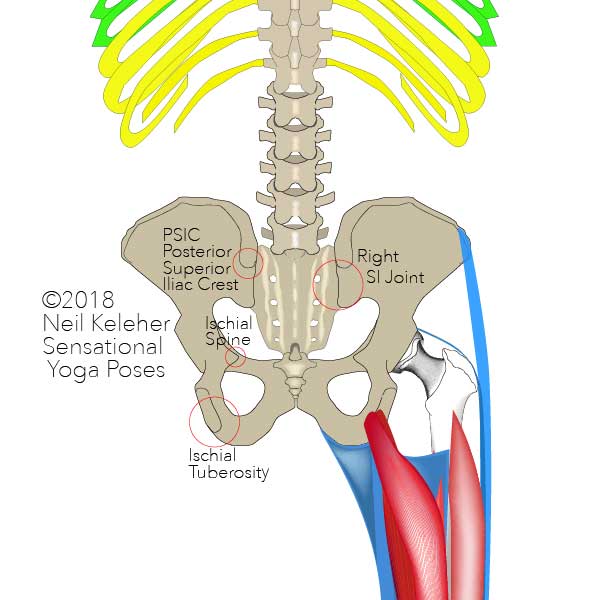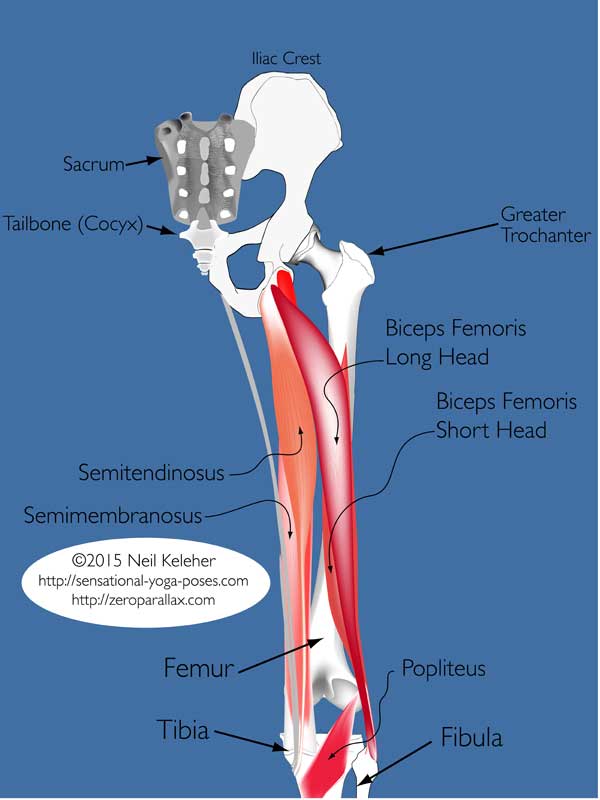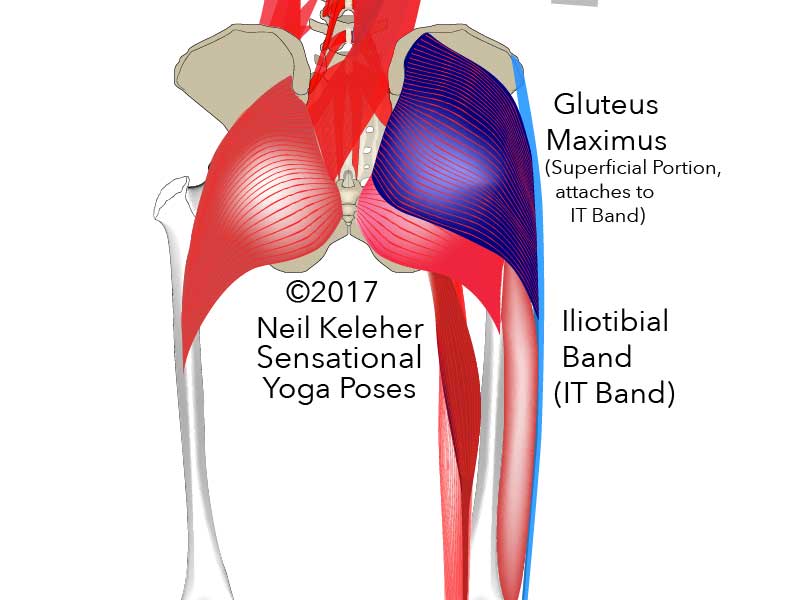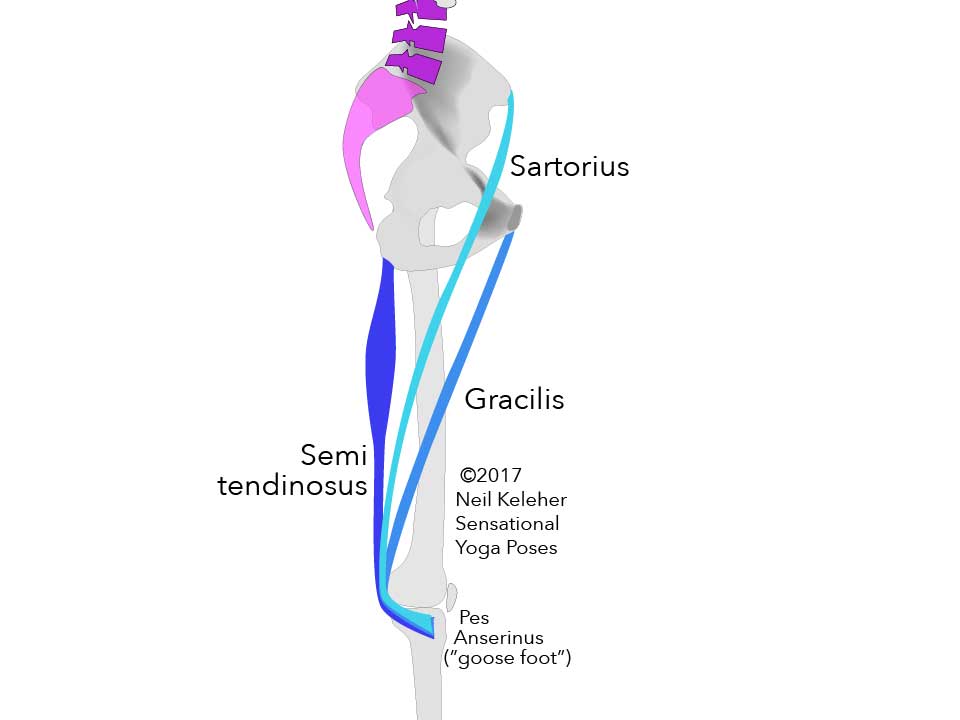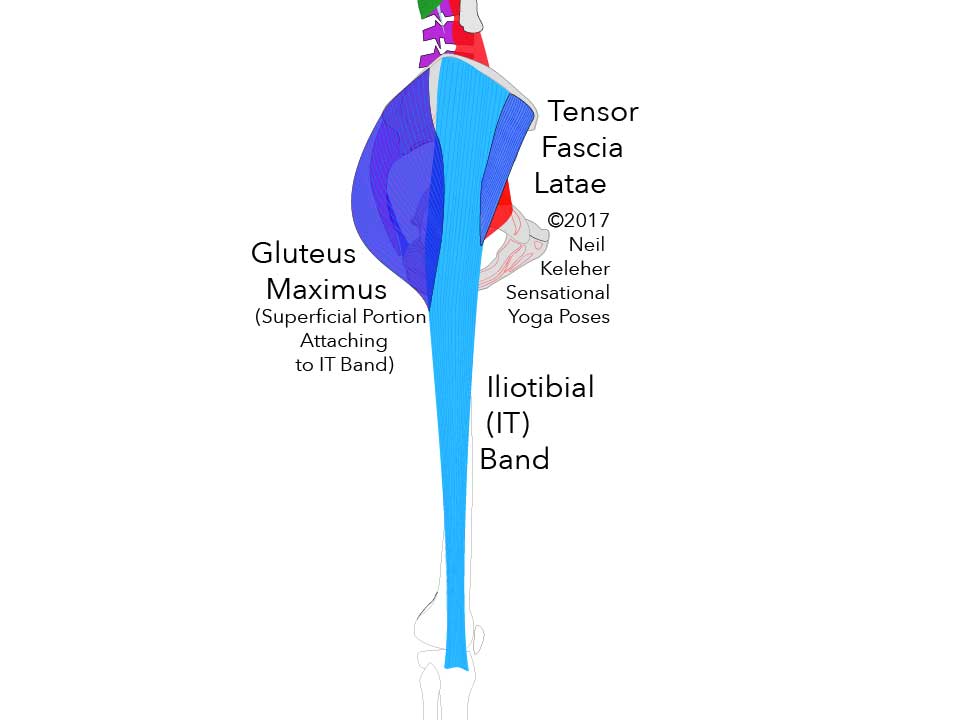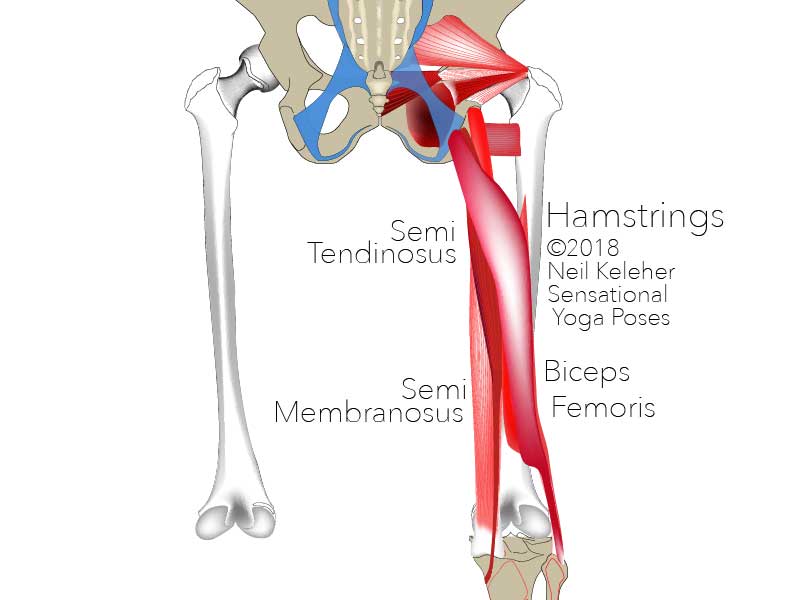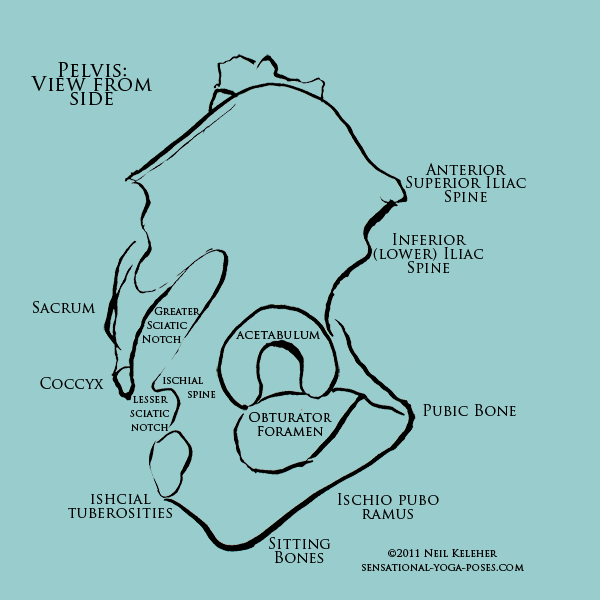One way to stabilize the hip bone is to use the pelvic floor muscles.
Activating the pelvic floor muscles with a reasonably flat lumbar curve, you may be using them against the lower band of the transverse abdominis muscle to stabilize the SI joints.
The lower band of the Transverse Abdominis muscles consists of the fibers that attach to the two ASICs and the inguinal ligaments.
When the pelvic floor muscles are activated (whether against the transverse abdominis or against the lumbar multifidus) you tend to stabilize both SI joints, effectively turning both hip bones and the sacrum (and lower lumbar vertebrae) into one unified mass.
With the pelvis "rigidized", the hip bones on both sides could be considered stable. They pelvis could then act as an anchor for the hip muscles, in particular the "long hip muscles" that act on both the hip and the knee.
Anchoring the long hip muscles
The long hip muscles include the Rectus femoris, Sartorius, gracilis, semitendinosus, semimembranosus, biceps femoris long head, superficial gluteus maximus and tensor fascia latae.
Standing on one leg while turning the pelvis (and/or swinging the free leg around) the pelvic floor muscles can help to support the SI Joints while also giving the long hip muscles an anchor point. Because the foot is bearing weight, these muscles not only use the pelvis as an anchor point (or reference), they also help to move it.
Stabilizing the foot and lower leg
Another way to give the long hip muscles a stable foundation is to stabilize the foot and lower leg. If the lower leg is stabilized against rotation (while at the same time supporting the weight of the body), the long hip muscles then have an anchor from which to act on the hip bone.
As well as anchoring the long hip muscles, a stabilized shin could also act as an anchor for the quadriceps, in particular the vastus muscles which all attach to the femur, as well as the popliteus muscle and the biceps femoris short head. All of these single joint knee muscles can act to help stabilize the femur relative to the lower leg bones.
Controlling the corner points of the hip bones
The long hip muscles all attach to prominent "corner points" of the hip bone, so despite being rather thin these muscles could be well placed to stabilize it.
Some of these muscles pass over the vastus muscles of the quadriceps. With the vastus muscles activated, extra tension can be added to the IT band, rectus femoris, sartorius, and gracilis making it easier for these muscles to stabilize the hip bone. With the quadriceps also working against the hamstring muscles (which are also "long hip muscles") the femur is further stabilized at the knee joint.
Muscles that attach to the sacrum
There are muscles that attach to the front and rear surfaces of the sacrum from either the hip bone, the femur and the tibia.
- the piriformis attaches between the femur and the front surface of the sacrum,
- deep fibers of the gluteus maximus attaches between the sacrum and the hip bone,
- superficial fibers of the gluteus maximus attach between the sacrum and the tibia (via the IT Band).
With the tibia, femur and hip bone stabilized, these muscles have a fixed anchor point. Crossing the SI joint to attach to the sacrum they can then work against each other to help stabilize it.
Note that in this case, the SI joint on the same side as the supporting leg can be stabilized.
How to relax the pelvic floor muscles
Someone wrote on facebook about turning the hips while standing on one leg and how it caused their pelvic floor to activate. Trying the same thing myself, I did find that my pelvic floor activated while turning my hips (and "waving" my free leg around). However, making my standing shin rotationally stable I found that at the time my pelvic floor relaxed (or seemed to).
Perhaps more critically, the pelvic floor is activating to help stabilize the SI joints.
Stabilizing a single SI joint
One possible starting point for stabilizing a single SI joint is first stabilizing the same side shin (the "ipsilateral shin") against rotation.
Standing with weight on one leg or both legs, you could stabilize the foot and shin of one leg against rotation and from there activate the long hip muscles to stabilize the same side hip bone. That may then be enough to stabilize the same side SI Joint.
But in case it isn't, you could lengthen the spine.
Lengthening the spine
I've devoted a whole online video course to spinal awareness and lengthening the spine in general. (It includes improving ribcage awareness, as well as transverse abdominis awareness). You can find out more about that here: learn to feel and control your spine video course. For a complimentary course that includes operating the SI joints (via the hip bones) and the spine, check out the learn to feel and control your spine and SI joints course.
Lengthening doesn't necessarily mean straightening
Lengthening the spine doesn't necessarily mean making the spine straight.
It's simply an instruction which helps students to activate the smaller muscles (as well as the longer muscles) of the spine. The simple act of making the spine feel long causes muscles to activate to create sensation.
Including the sacrum when lengthening the spine
For the muscles of the spine to be continually active they have to work against each other which helps to stabilize the spine. Including the sacrum in this "spine lengthening exercise" means that muscles are activated in the sacral region also (the sacral multifidus for example).
Muscles that help make the lumbar spine and sacrum feel long
Making the lumbar spine feel will activate either the psoas or the quadratus lumborum depending on the amount and direction of bend in the lumbar spine and also the amount of front to back bend in the hip joint. Making the sacrum also "feel long" will possibly activate the piriformis and possibly elements of the gluteus maximus.
Anchoring the shin bones and then the hip bone
Note that both piriformis and gluteus maximus have fibers that attach to the hip bone. And so anchoring the shin bone first, then using the long hip muscles to stabilize the hip bone gives these muscle fibers a firm foundation from which to act on the sacrum. That in combination with making the sacrum and lumbar spine feel long may help to secure the same side SI joint.
There is a lot more going on than I am describing (and a lot more going on than I understand) but consciously creating this stability may give other muscles the base that they need to create stability where ever else it is needed.
In seated poses where the leg (or legs) aren't bearing body weight, this may mean stabilizing the foot and ankle
Stabilizing the Shin to Rotate the Pelvis
Now first of all, it may be possible to turn the pelvis while on one leg without the pelvic floor muscles turning on.
If you stabilize the foot and ankle you are standing on in such a way that the shin of that leg resists rotation you may find that you can repeatedly turn your pelvis without your pelvic floor muscles activating.
It may go without saying that you need to stabilize the foot you are standing on in this type of exercise, but stabilizing the foot and stabilizing the shin against rotation are two slightly different affairs.
The Correlation Between Shin Rotation and Arch Lift
So for example, with the foot stable, what you may find is that your shin turns as you turn your pelvis and as a result the inner arch of the foot noticeably changes, lifting as the shin rotates externally and sinking or collapsing as the shin rotated internally.
With the shin stabilized against rotation, the change in shape of the inner arch of the standing foot is minimal. Keeping the arch fixed is part of what helps to stabilize the shin against rotation.
But this doesn't answer the question as to why stabilize the shins to rotate the pelvis?
Hip Rotators that Cross the Knee Joint
There are several muscles that attach from the pelvis to the shin.
- These could be considered hip rotators if the shin is stable.
- If the pelvis is stable then they could be considered shin rotators.
By stabilizing the shins against rotation you give these muscles a stable foundation from which they can rotate the pelvis.
The Sartorius and Tensor Fascia Latae both attach to the ASICs and from there to the inside and outside of the tibia respectively.
The Semitendinosus and Biceps Femoris Long Head both attach to the ischial tuberosity or sitting bone and from there to the fibula and inside of the tibia respectively.
Fibers of the Gluteus Maximus attach from the posterior portion of the iliac crest and like the tensor fascia latae attach to the outer surface of the tibia while the Gracilis attaches from a point near the pubis to the inside of the tibia.
To recap from a slightly different point of view:
The sartorius, gracilis and long head of the biceps femoris all attach to the inside surface of the tibia. They tie together to form what looks like a goose foot and so is called, in latin, pes anserinus.
The Tensor Fascia Latae and fibers of the Gluteus maximus attach to the outer surface of the tibia, in front of the fibula.
The Biceps Femoris Long Head attaches to the fibula (which is positioned against the outside of the tibia).
Note how all of these muscles attach to prominent points of the hip bones:
- The Anterior Superior Iliac Crest (ASIC)
,
- Posterior portion of Iliac crest ,
- Ischial Tuberosity (sitting bone),
- Pubic Bone.
You could think of these points as forming the corners of the cube that houses the pelvis.
As a result these muscles can be useful in rotating the pelvis, assuming that they have a fixed or stable anchor point from which to act.
With the shins stabilized against rotation these muscles have a stable foundation from which they can be used to help turn the pelvis.
With the shins not stabilized, an option is to stabilize the pelvis instead.
The SI Joints Make the Pelvis a Flexible Structure
The pelvis is made up of three bones that are joint at the pubic bone and the SI joints. The "flexibility" of the pelvis is what enables it to endure the strain of transmitting forces between the legs and spine.
Stabilizing the Pelvis with Some Help from the Pelvic Floor
With the pelvis stabilized, the hips bones and sacrum could be more or less locked together to stabilize the bones of the pelvis. That could be achieved with some help from the pelvic floor muscles.
When active these muscles pull inwards on the ischial tuberosities, which because of the way that the SI joints work, causes the ASICs to move outwards.
Opposing the Pelvic Foor Muscles with the Transverse Abdominis
Note that when the pelvic floor muscles activate you may find that the lower transverse abdominis activates also.
These muscles work in opposition.
Where the pelvic floor muscles pull inwards on the ischial tuberosities causing the ASICs to move outwards, the lower transverse abdominis pulls inwards on the ASICs causing the ischial tuberosities (sitting bones) to move outwards.
Note that if in activating the pelvic floor all you do is pull your tailbone towards the pubic bone, you may not get this result.
Full pelvic floor activation includes pulling the sitting bones inwards and even creating a fan of tension from the sitting bones forwards all the way to the pubic synthesis.
One way to get a full (or relatively full) pelvic floor contraction is to tighten your anus and/or pull it upwards.
The Biomechanics of Turning the Pelvis, Acting on the ASICs
With the pelvic floor muscles and lower transverse abdominis muscles activated to stabilize the pelvis, the Tensor Fascia Latae could activate and pull the ASICs outwards rotating the pelvis to the same side as the supporting leg.
For all the descriptions that follow, assume that it is the muscles of the standing leg that are doing the work.
The Tensor Fascia Latae would be resisted by the transverse abdominus and as a result pelvic floor tension might lessen slightly.
To turn in the opposite direction (away from the standing leg side) the sartorius could activate pulling inwards on the ASIC and that would be resisted by the pelvic floor and perhaps cause a slight reduction in transverse abdominus tension.
The Biomechanics of Turning the Pelvis, Acting on the Ischial Tuberosity
Focusing on the sitting bone, the biceps femoris could be used to turn the pelvis away from the standing leg side. It would pull outwards on the sitting bone. That pull could be resisted in part by the pelvic floor musculature.
Going the opposite way the semitendinosus could be used to turn the pelvis towards the standing leg side. It's pull could be resisted by the transverse abdominus.
General Turning of the Pelvis with the SI Joints Stabilized
To turn the pelvis towards the standing leg side you could use the Tensor Fascia Latae and semitendinosus together. Both could work against the transverse abdominus.
To turn the pelvis away from the standing leg side you could use the sartorius and biceps femoris. Both could work in part against the pelvic floor muscles.
With the SI joint (and thus the pelvis) stabilized, the brain has a reference of sorts for controlling the body.
The pelvis is "stabilized" and so it controls these hip and knee muscles so that the try to rotate the shin relative to the pelvis. Because the foot is on the floor the result is that the pelvis turns.
General Turning of the Pelvis with the Shin Stabilized Against Rotation.
With the shin stabilized against rotation the brain has a different reference point.
The shin is stabilized and so it controls these hip and knee muscles so that they try to rotate the pelvis relative to the shins. And as a result the pelvis turns.
What About the Deep Hip Rotators?
There will be other muscles involved in all of this. These muscles won't act in pure isolation.
While the deep hip rotators will also probably be active, especially while standing on one leg, I'd suggest that their main job may be in maintaining hip joint integrity, helping to keep the hip joint capsule tensioned in such a way that it prevents lubricating fluid (synovial fluid) from being squeezed out from between the ball of and socket of the hip joint.
Related
For more on the anatomy and biomechanics of stabilizing the shins against rotation read The foot
For more on joint lubrication (keeping joint capsules tensioned) read the sexily titled: Hydrostatic Lubrication in Articular Joints, Fluid Tensegrity Joint Anatomy and
Published: 2020 08 14
Updated: 2021 01 29
